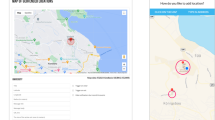Abstract
Researchers utilize mobile imaging, pervasive sensing, social media, and location tracking (MISST) technologies to observe and intervene with participants in their natural environment. The use of MISST methods and tools introduces unique ethical issues due to the type and quantity of data, and produces raising new challenges around informed consent, risk assessment, and data management. Since MISST methods are relatively new in behavioral research, there is little documented evidence to guide institutional review board (IRB) risk assessment and inform appropriate risk management strategies. This study was conducted to contribute the participant perspectives when considering ethical and responsible practices. Participants (n = 82) enrolled in an observational study where they wore several MISST devices for 1 week completed an exit survey. Survey items focused on the following: 1—device comfort, 2—informed consent, 3—privacy protections, and 4—bystander engagement. The informed consent process reflected participant actual experience. Device comfort and privacy were raised as concerns to both the participants and bystanders. While the majority of the participants reported a positive experience, it is important to note that the participants were volunteers who were not mandated to wear tracking devices and that persons who are mandated may not have a similar response. Findings support strategies proposed in the Kelly et al. (2013) ethical framework, which emphasizes procedures to improve informed consent, protect privacy, manage data, and respect bystander rights when using a wearable camera.



Similar content being viewed by others
Notes
Reprinted from American Journal of Preventive Medicine 2013; 44(3): 314-319, Kelly, P. et al. “An Ethical Framework for Automated, Wearable Cameras in Health Behavior Research” with permission from Elsevier.
References
Kumar S, Nilsen WJ, Abernethy A, et al. Mobile health technology evaluation: the mHealth evidence workshop. Am J Prev Med. 2013; 45(2): 228-236. doi:10.1016/j.amepre.2013.03.017.
Jankowska M, Schipperjin J, Kerr J. A framework for using GPS data in physical activity and sedentary behavior studies. Exerc Sport Sci Rev. 2015; 43(1): 48-56.
Zenk S, Schulz A, Odoms-Young A, et al. Feasibility of using Global Positioning Systems (GPS) with diverse urban adults. J Phys Act Health. 2012; 9: 290-296.
Kerr J, Marshall SJ, Godbole S, et al. Using the SenseCam to improve classifications of sedentary behavior in free-living settings. Am J Prev Med. 2013; 44(3): 290-296. doi:10.1016/j.amepre.2012.11.004.
Doherty AR, Kelly P, Kerr J, et al. Use of wearable cameras to assess population physical activity behaviours: an observational study. Lancet. 2012; 380: S35. doi:10.1016/S0140-6736(13)60391-8.
Doherty AR, Kelly P, Kerr J, et al. Using wearable cameras to categorise type and context of accelerometer-identified episodes of physical activity. Int J Behav Nutr Phys Act. 2013; 10: 22. doi:10.1186/1479-5868-10-22.
Oliver M, Doherty AR, Kelly P, et al. Utility of passive photography to objectively audit built environment features of active transport journeys: an observational study. Int J Health Geogr. 2013; 12: 20. doi:10.1186/1476-072X-12-20.
Hodges S, Williams L, Berry E, et al. SenseCam: a retrospective memory aid. In: Ubicomp 2006, LNCS 4206. 2006; 177–93. doi:10.1007/11853565.
Nebeker C, Linares-Orozco R, Crist K. A multi-case study of research using mobile imaging, sensing and tracking technologies to objectively measure behavior. J Res Adm. 2015; 46(1): 118-137.
US Department of Health and Human Services. Protection of human subjects. 45 CFR 46. 1964.
National Commission for the Protection of Human Subjects of Biomedical and Behavioral Research. The Belmont Report: ethical principles and guidelines for the protection of human subjects of research. 1978. Available at: http://ohsr.od.nih.gov/guidelines/belmont.html.
Kelly P, Marshall S, Badland H, Kerr J. An ethical framework for automated, wearable cameras in health behavior research. Am J Prev Med. 2013; 1–6. Available at: http://www.sciencedirect.com/science/article/pii/S0749379712008628.
Anderson EE, Dubois JM. IRB decision-making with imperfect knowledge: a framework for evidence-based research ethics review. J Law, Med Ethics. 2012; 40(4): 951-969. doi:10.1111/j.1748-720X.2012.00724.x.
Christie G, Patrick K, Schmuland D. Consultation for collective action on personalized health technology: eliminating the ethical, legal and social barriers for individual and societal benefit. J Health Commun. 20:867–868.
Acknowledgments
We would like to thank the iWatch participants for contributing to this study. We also acknowledge Lindsay Dillon, MPH, who contributed to the development of the survey and Elizabeth Booen, MS, who assisted with the data management.
This study was conducted with the participants from the NCI-funded Validating Machine-Learned Classifiers of Sedentary Behavior and Physical Activity study (PI Kerr, Grant # R01CA164993, IRB # 111160). We also acknowledge the Robert Wood Johnson Foundation’s support of the Connected and Open Research Ethics (CORE) initiative (PI Nebeker, #72876, 2015-2017) and the Impact of Privacy Environments for Personal Health Data on Patients (PI Bloss, R01 HG HG008753)
Author information
Authors and Affiliations
Corresponding author
Ethics declarations
Conflict of interest
The authors declare that they have no conflicts to report.
Informed Consent Statement
All procedures followed were in accordance with the ethical standards of the responsible committee on human experimentation (institutional and national) and with the Helsinki Declaration of 1975, as revised in 2000. Informed consent was obtained from all patients for being included in the study.
Additional information
Manuscript prepared for re-submission to Translational Behavioral Medicine
Implications
Practice: Stakeholders, including institutional review boards (IRBs), behavioral scientists, and research participants must work collaboratively to advance evidence-based ethical practices responsive to research using emerging technologies.
Policy: Regulations and ethical practices for human research protections must evolve to meet the needs of dynamic twenty-first century science.
Research: There is a growing need for empirical research to 1—“inform” the informed consent process, 2—qualify and quantify the magnitude and probability of potential risks, and 3—guide data management strategies when collecting new forms of personal health data.
APPENDIX
APPENDIX
iWatch Exit Survey version 2: 041514
iWatch Exit Interview
Thank you for participating in the iWatch study this week. We are interested in learning more about your experience with the devices.
Please answer the following questions.


About this article
Cite this article
Nebeker, C., Lagare, T., Takemoto, M. et al. Engaging research participants to inform the ethical conduct of mobile imaging, pervasive sensing, and location tracking research. Behav. Med. Pract. Policy Res. 6, 577–586 (2016). https://doi.org/10.1007/s13142-016-0426-4
Published:
Issue Date:
DOI: https://doi.org/10.1007/s13142-016-0426-4




